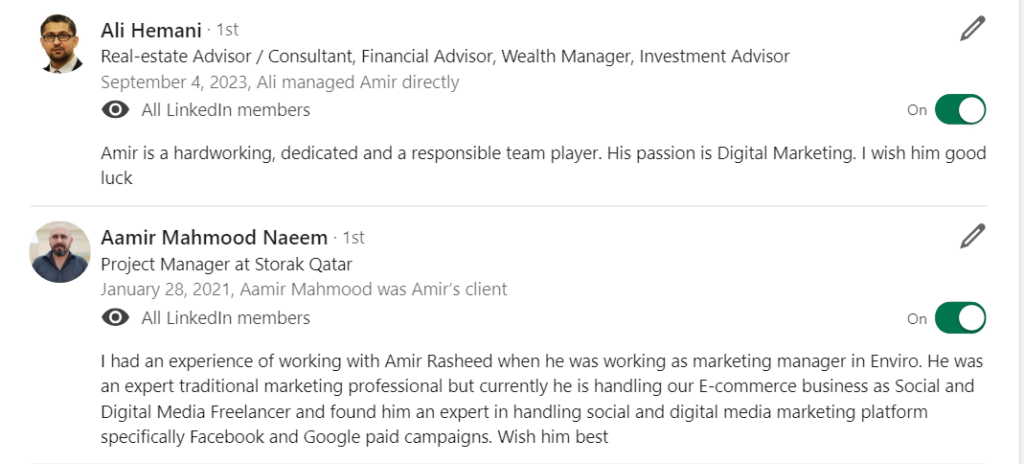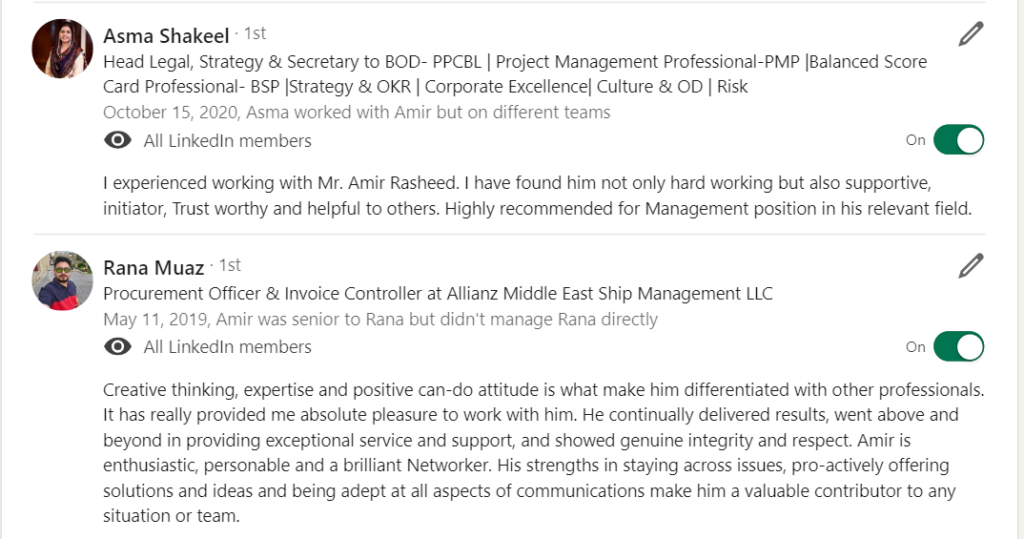
Amir Rasheed
Omnicycle marketing professional
Performance-Driven Marketer with ATL, BTL & Digital Expertise
LinkedIn & Google Certified | Meta Expert
17+ years of Experience
Seasoned marketing professional with proven experience across diverse industries like banking, FMCG, Telecoms, and marketing research.
Digital
I transform businesses through data-driven digital marketing campaigns. Google & LinkedIn Certified, Meta Marketing Expert. Optimized 2000+ digital media campaigns
ATL
Developed integrated marketing campaigns through collaboration with creative and media buying agencies, resulting in successful TV, radio, and print advertising
BTL
Increased brand awareness and customer loyalty by managing corporate events, sponsorships, and a cohesive branch branding strategy.
PR
Spearheaded traditional and digital PR initiatives to enhance brand awareness that significantly improved brand perception.
Highlights of
Experience
askari bank

Head Marketing Jan22-Oct 23
Responsible for 360 Degree Marketing including ATL, BTL, PR and Digital Platforms
Head Corporate Communication - Oct 23- Currently
Bareeze

Digital Marketing Lead (May 21 - Jan 22) Spearhead data-driven digital marketing campaigns from strategy to execution, measuring performance against goals (ROI & KPIs) and optimizing for success
consultant

Digital Marketing Consultant & Trainer.
I crafted winning strategies and drive results for fashion, multi-brand, and lifestyle businesses.
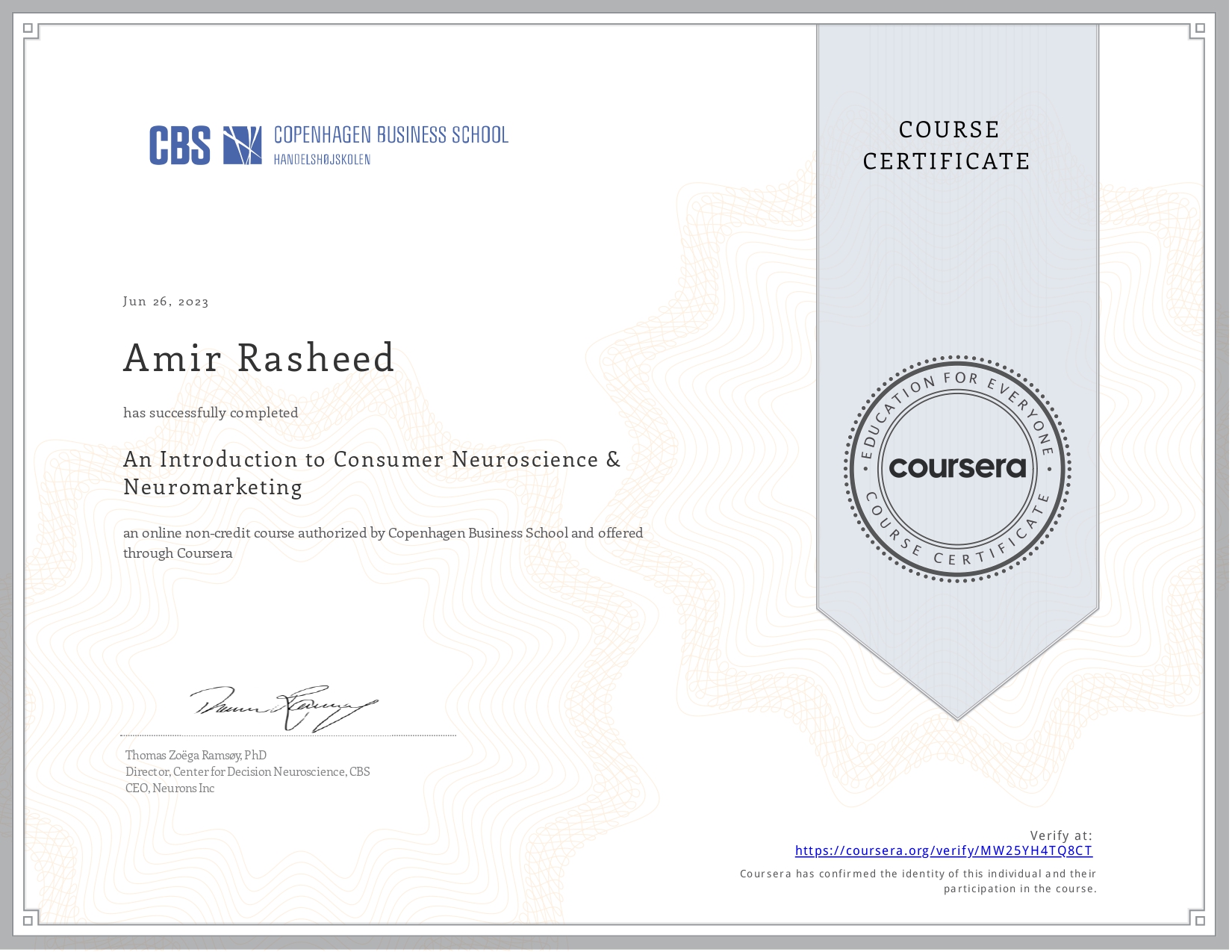


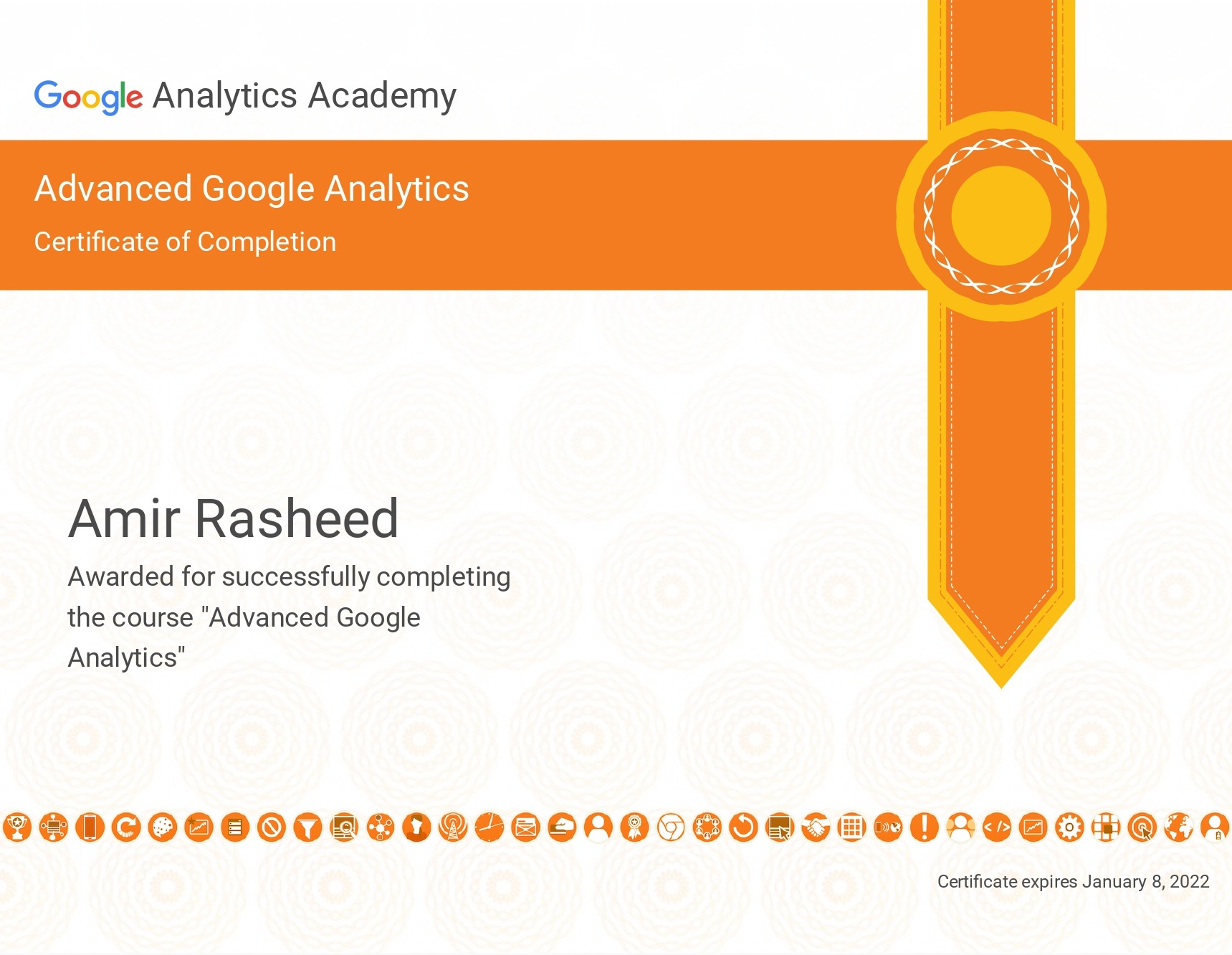

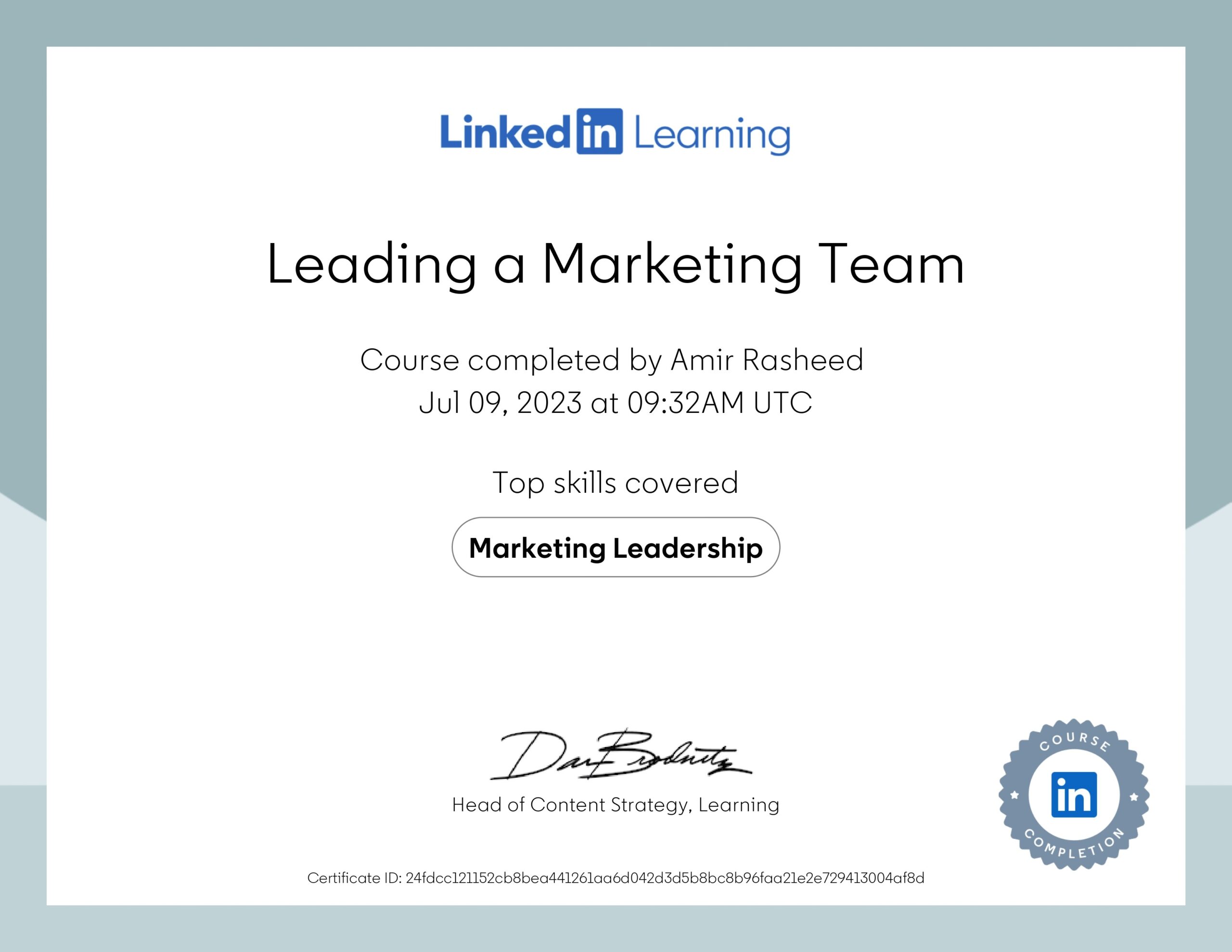
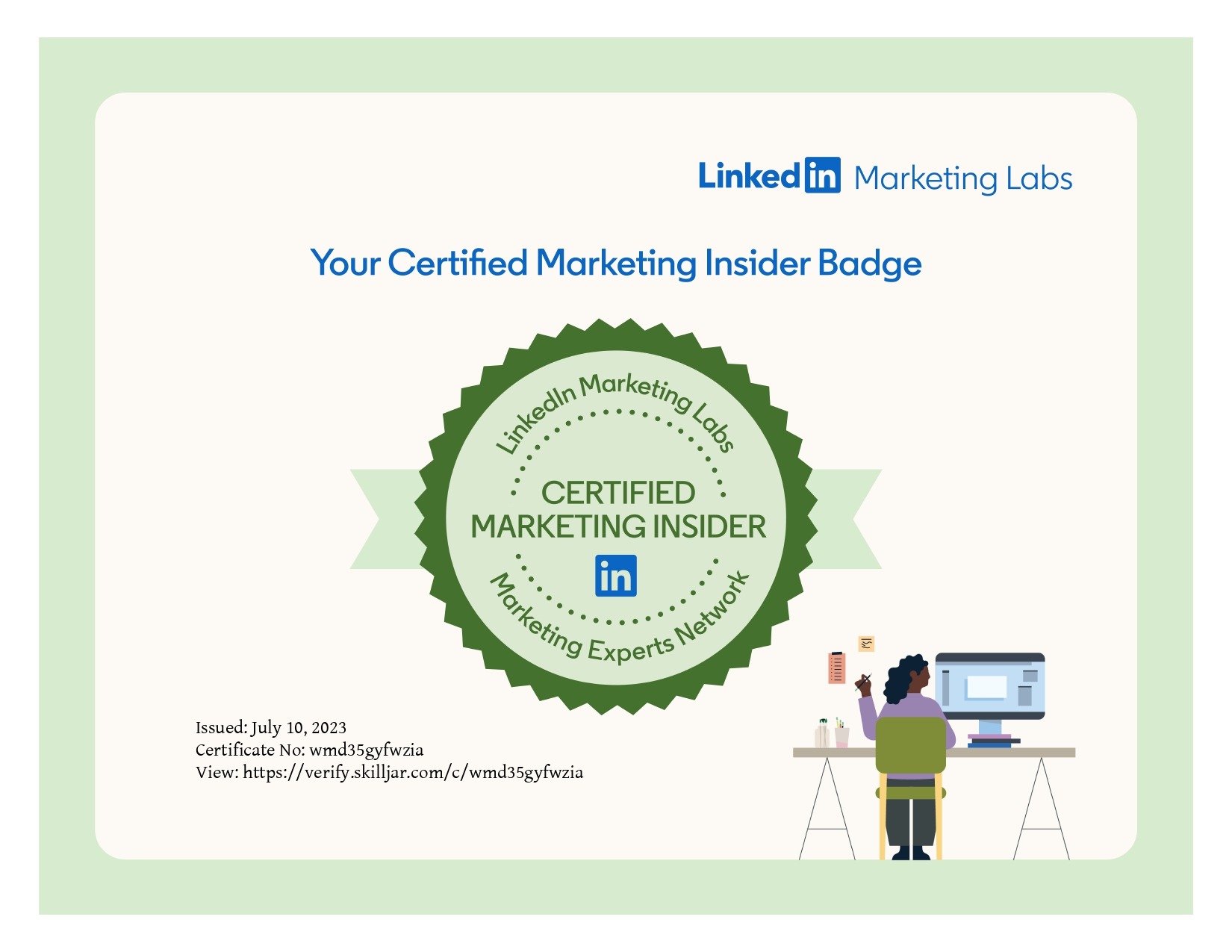
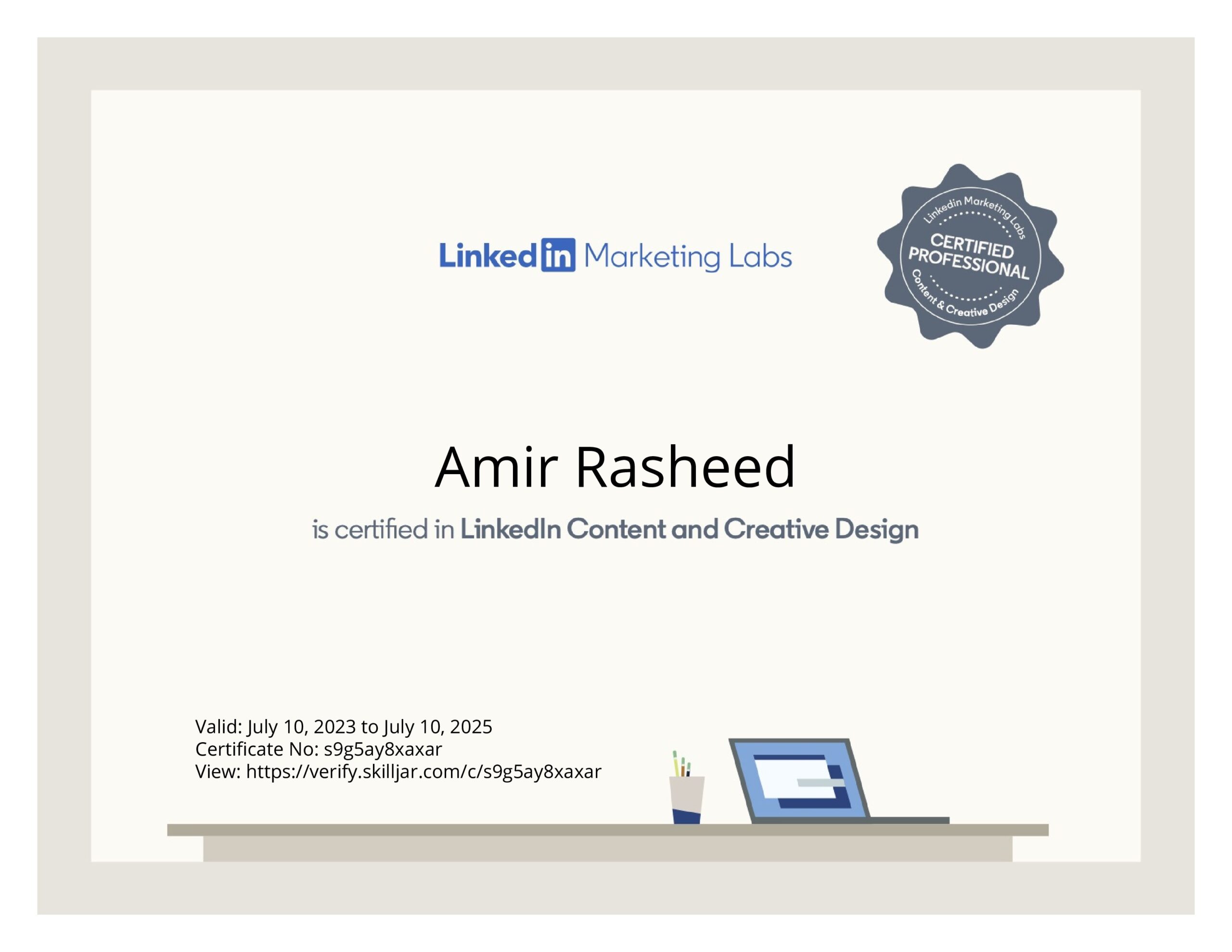
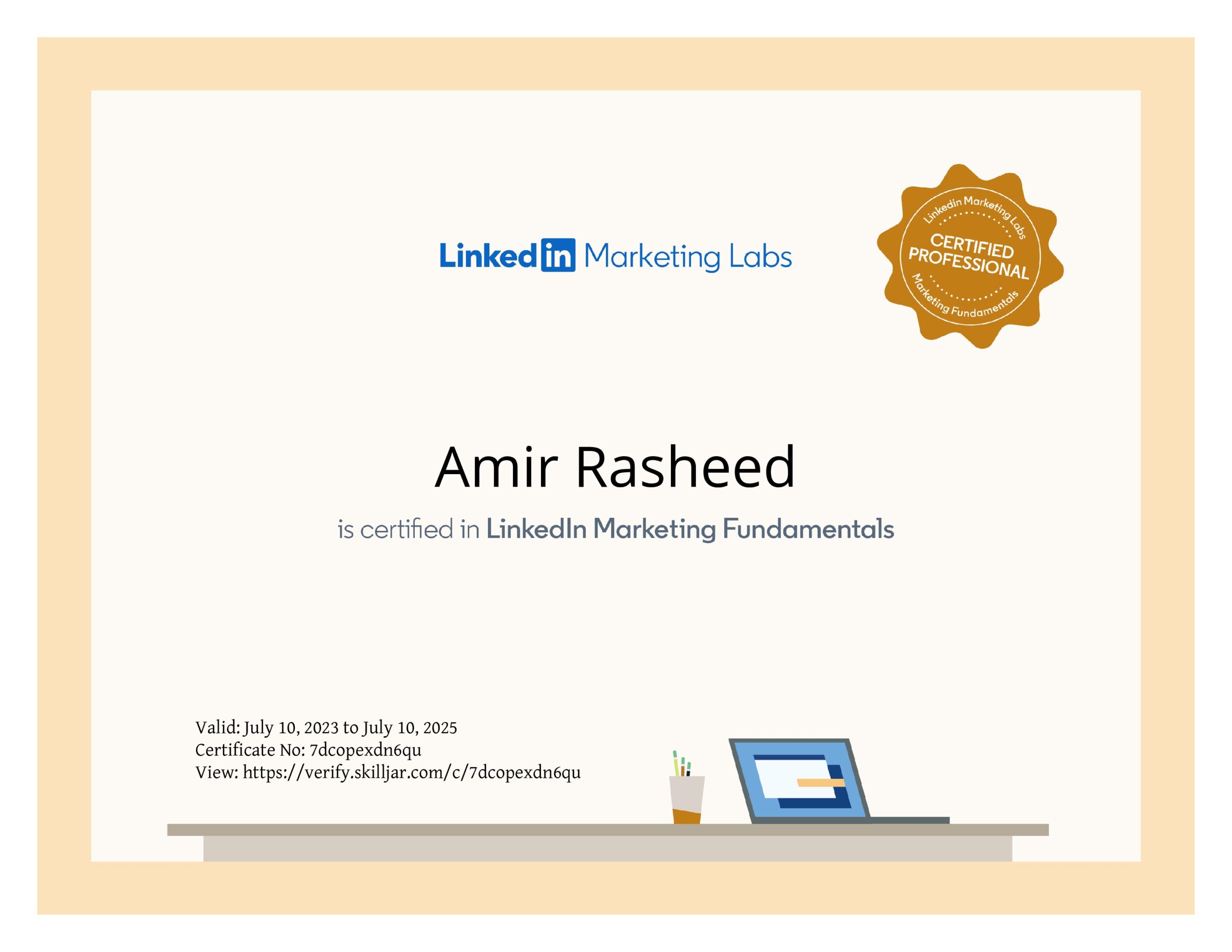


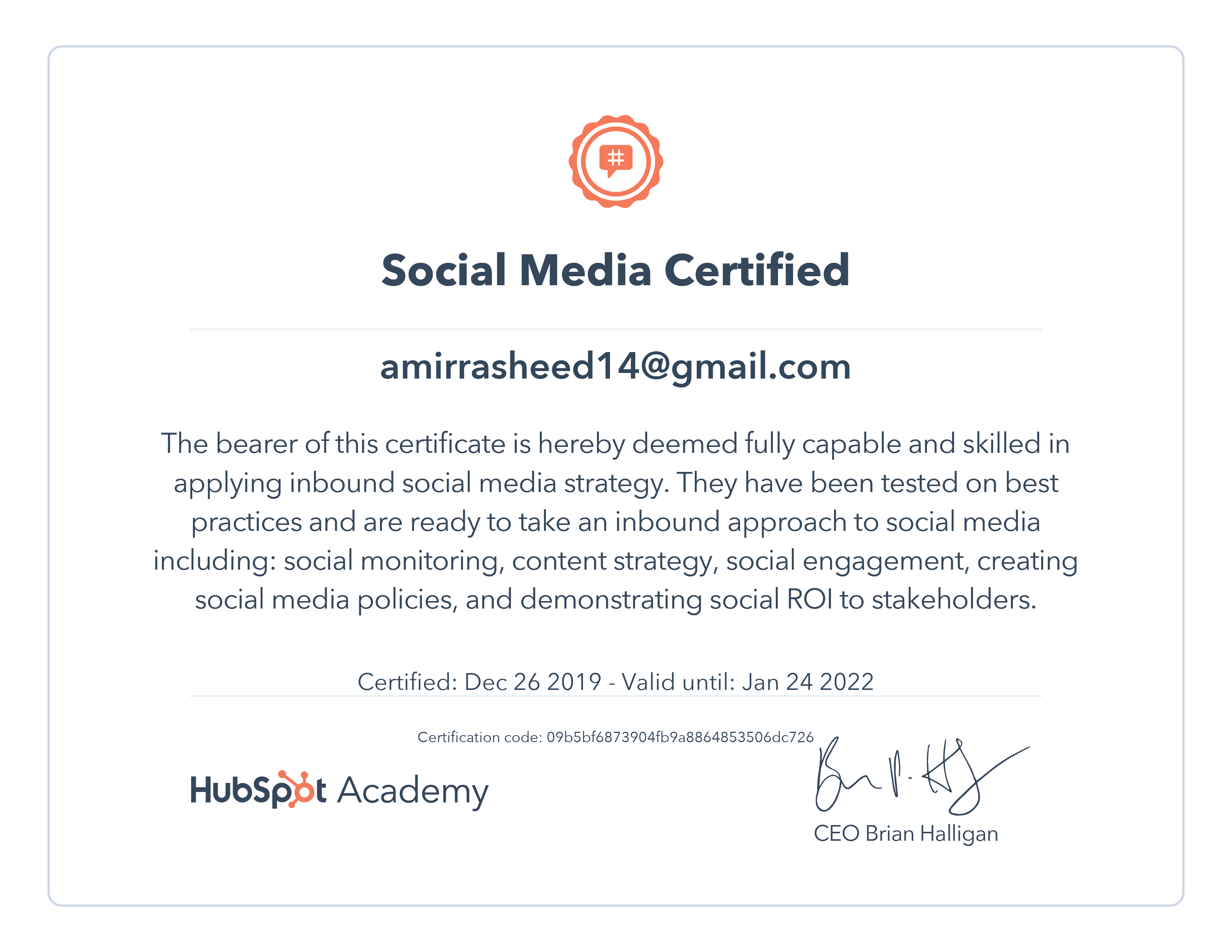
WINNING IDEA - Social Selling & Employee Advocacy
Winner of FINCA Innovation Award 2018
20 participating countries
Ideas worth Millions
QR Code in marketing
gO GREEN

Introduced a sustainable solution by replacing printed marketing materials with QR codes at POS, resulting in both cost savings and environmental benefits
Customer feedback

Implemented a customer feedback system using QR codes across all branches. This innovative approach, linked to Google Business Listings, empowers customers to share their experiences directly
Employee Advocacy
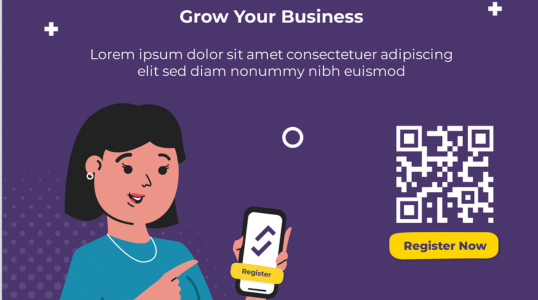
Utilized QR codes to make crucial corporate communications readily accessible to employees. By scanning the codes, employees can download and share these messages on their social media, promoting employee engagement
My YouTube tutorials have empowered over 3,000 individuals to learn digital marketing at no cost.
4,000+ Hours Watch Time
My YouTube tutorials have captivated viewers for a combined 4,000+ hours over the past year
2,500+ Subscriber
My YouTube tutorials empower a growing community of over 2,500 loyal viewers who consistently learn valuable digital marketing skills
250 Free Tutorial
100% Practical video on the topic of Digital Marketing, Facebook & Instagram Marketing, Google & YouTube Marketing, and SEO etc
250+ Free Consultation
Guiding marketing newcomers through the process of crafting and optimizing digital marketing campaigns
are you thinking...
How can i add value to your business
“With 17+ years of experience in Integrated Marketing Communications (IMC) across diverse industries like Banking, FMCG, Telecom, and Market Research, I bring a well-rounded perspective to crafting effective marketing strategies. I’m passionate about using data to inform my decisions. My Google and LinkedIn certifications and Meta expertise allow me to stay up-to-date on the latest digital marketing trends and leverage data analytics to develop targeted campaigns that deliver measurable results.
I’m confident I can add significant value to your organization by developing data-driven IMC campaigns that achieve your specific marketing goals.”
_amir rasheed

Experience chronology
- Unit Head of Corp Communications Jan 2024 – Present
Head of Marketing Jan 2022 – Jan 2024
- Collaborate with business team to uncover insights for developing marketing strategies for existing and new products
- Crafting strategies for all Marketing teams, including ATL, BTL, Digital Media and Creative
- Conception, development and implementation of Integrated Marketing Communication to drive sales
- Leading digital media agency, creative agency, media buying agency and PR agency.
- Efficiently managing annual marketing budgets.
- Streamlining marketing operation flow and etc.
- Preparing and managing monthly, quarterly and annual budgets for the Marketing department
- Routinely sharing strategies, progress, results, learnings, and relevant industry trends, with the broader team.
- Setting, monitoring and reporting on team goal
Projects
Marketing Lead (Digital Media and Traditional) May 2021 – Jan 2022
1-The Fabric Store (Shopify platform)
https://www.thefabricstore.pk/
https://www.instagram.com/thefabricstorepk/
https://web.facebook.com/thefabricstorepk
2-Bareeze Home Expression (Magento platform)
https://www.bareezehome.com.pk/
https://web.facebook.com/HomeExpressions
https://www.instagram.com/bareeze_homeexpressions/
Achievements:
o More than 35% increase in the Conversion Funnel
o Decreasing the Bounce Rate upto 20% by selecting the right Target Audience
o More than 100% increase in sales by focusing on Retargeting and Prospecting campaigns
• Digital Marketing
o Strategizing the digital campaigns based on Sales Funnel (TOFU, MOFU, and BOFU)
o Work with digital marketing agency to plan and execute all digital marketing campaigns including SEO, social media (Facebook and Instagram), Google display, Google Search, and YouTube advertising campaigns
o Design, build and maintain content for social media presence
o Measure and report performance of all digital marketing campaigns using Google Analytics, and assess against goals (Conversion Rate, ROAS and etc )
o Collaborate with agencies to create landing pages and optimize user experience
o Integrating and Fixing Google analytics, Google Search Console, Google My Business, Google Merchant Center, Facebook Pixels, Facebook Catalogues and etc
• Traditional Marketing
o Interaction with marketing vendors to streamline branding related tasks which include but not limited to offset printing, stores branding, etc
o Work with in-house designer team to execute Campaign and web shoot
Aug 2020 – Jan 2022
Executed 500+ Paid campaigns on Facebook and Google Ad
Social and Digital Media Marketing Trainer
~ Project-1: www.jangomall.com – Digital Marketing consultant (Dec 2020 till Jan 2022)
Jangomall is an E-commerce platform of multi-brands
Managing all digital marketing including SEO/SEM (Search Engine Optimization / Marketing), PPC
(Pay-per-click), Social Media Marketing (Facebook and Instagram), and Content management.
~ Project-2: www.gotapati.com – Digital Marketing consultant (Feb 2021 till Jan 2022)
Gotapatti.com is an E-commerce platform of Ladies Fashion Garments
~ Project-3: Websites making a- www.bricksandcompass.com b- www.click2smile.com
~ Project-4: Google Video Campaign of Youtube Gaming Channel (Jan 2021 till Jan 2021)
~ Project-5: Launch Readiness of MidCity Housing Society (Oct 2020 till Dec 2020)
Tasks:
• Drafting go-to-market strategy
• On-boarding creative, digital & social media, media buying, and PR agencies.
• On-boarding outdoor activation, printing, and giveaways agencies
• On-boarding event execution agency
~ Project-6: Facebook page Management of Housing Construction Agency (Aug 2020 till Oct 2020)
Tasks:
• Optimization of Facebook page
• Paid campaign to increase likes and engagement
Senior Manager Marketing (Digital Marketing and Traditional Marketing) Jan 2017 – Aug 2020 · 3 yrs 8 mos
Planning yearly traditional and digital marketing budget and activities calendar to differentiate from the competition.
• Coordinating with the creative, digital media marketing, media buying, outdoor and PR agencies
• Supervising roadshows and corporate events’ sponsorships
• Production of TVCs and marketing collateral
• Managing branding and marketing material throughout FINCA Pakistan network – 136+ branches
Achievements:
• Instrumental in increasing App download, loan / deposit queries using digital marketing campaigns
• SimSim (Mobile Wallet) launch TVC and Launch Event
• Product TVC and Customer Success Stories videos for Social Media
• Multiple corporate events for FINCA and SimSim
• Special Assignment: Directly working with CEO for his major talks/key-note presentations to establish thought-leadership (covering industry-related topics) and showcase the DFS work-stream.
Marketing Manager (Traditional and Digital Media Marketing) Jun 2015 – Jan 2017 · 1 yr 8 mos
Enviro & Opple Lighting (sister concern of Haier)
- Responsibilities:
• Reporting to GM, steering a team of 4 in devising marketing activities for achieving business targets
• Drafting yearly traditional and digital marketing plans based on marketing budget of all products.
• Responsible for the ATL/BTL/Digital marketing campaigns of following product lines (AC, Microwave Oven, Small Domestic Appliances, Hoods & Hobs, Cooking Range, Instant Water Heater, Ceiling Fan, Bedroom Refrigerator, Water Dispenser, Inverter, and Battery)
Achievements:
• Played catalytic role in increasing sales from 1 Billion to 2 Billion
• Successfully launched exclusive displays of Enviro appliances & Opple Lighting throughout Pakistan.
• Designed new website of Enviro Appliances
• Viral marketing through ‘Enviro Women Community’ on Facebook
• Designed affiliate marketing ‘Students Earning Scheme’
Responsibilities:
• Reporting to the Manager Marketing, steering a team of 2 in executing marketing activities.
• Drafting marketing budgets and media tools for effective reach.
• Briefing & managing agencies (offline media, creative, web team and PR).
• Assist to art team on all planning and details for photo, video shoots and marketing collateral designs.
• Prepare sales forecast in coordination with the management team for each financial year.Achievements:
• Capitalized on marketing budget of PKR 30 million for the launch of Al Razi in Lahore
• Instrumental in achieving PKR 10 Million sales in first 100 days
• Build brand awareness upto 40% within three months of launch through targeted communication
• Reporting to the Head of Marketing, steering a team of 2 in devising communications strategies for consumer segments
• Work with product and research team to communicate market trends and customer requirements to ensure alignment of product development strategy with the voice of customer specific to each segment
• Work with the management team to prepare a core brand message and apply these into all aspects of media
• Work with sales team to maximize lead generation, direct marketing, and customer retention in support of segment objectives
• Participate in sales forecasting and reviewsAchievements:
• Played a pivotal role in successfully launching Asia’s largest Wi-Max operation
• Played important role in drafting offline and online marketing strategy for Wateen Calling Card, Wateen Gaming, Wateen Fixed Line, Wateen Video Calling and Wateen Surveillance
• Instrumental in achieving 100,000 broadband customers within a period of 6 months
• Conducted Broadband Market Evaluation Research Study (Usage, Attitude & Segmentation) and developed market segmentation portfolio.
• Essayed an integral role in creative and media buying agency pitches and evaluations
• Capitalized on marketing budget of $1.8 million for the launch of Wateen
Some of main duties in Oasis Insights were;
• Preparation of research proposal
• Questionnaire design
• Analyzing data
• Preparing final reports
• Project work plan
• Execution of project within scheduled time frame
• Undertake periodic visits to existing clients with the objective of understanding their requirement
• Identifying prospective organization with which Oasis does not have a client relationship and etcAchievements:
• Quantitative research for Nestle to monitor brand score card of following categories (dairy, juices and mineral water) measuring – top of mind, unprompted & prompted awareness, buying behavior, switching pattern, disposition analysis, image & equity, solus and multiple user ship of brand / cat).
• Concept and product test of toddler related product – New Cerelac for Nestle
• Product and favorability test of powder milk category for Nestle
• Listing exercise to evaluate the market size of fruit juice category for Nestle
• Measuring the incidence of the culinary products for Nestle
• Repositioning of product line for ICI
• Saving habits of people belonging to lower SEC for Agha Khan Agency for Micro finance
• Concept test of product related to chewing gum category for Mayfair
What's my secret sauce?
Lets learn
Have you ever poured your heart and soul into a marketing campaign, only to see crickets chirping in response? It’s a frustrating scenario, but one that can often be avoided by understanding your target audience on an intimate level. This is where the concept of a consumer persona comes in.
What is a Consumer Persona?
Imagine your ideal customer walking into your store or visiting your website. What are they wearing? What are they looking for? A consumer persona is a fictional character that embodies the characteristics of your ideal customer segment. It goes beyond demographics like age and income, delving into their psychology, behaviors, and online habits. Think of it as a detailed profile that breathes life into your target audience.
How to Create a Compelling Consumer Persona:
Crafting a well-rounded consumer persona requires research, empathy, and a touch of imagination. Here’s a breakdown of the key steps, with additional details to consider:
-
Gather Data: Don’t build your personas in a silo. Leverage a variety of sources to paint a well-rounded picture:
- Market Research Reports: Industry reports can provide valuable insights into market trends, customer demographics, and competitor analysis.
- Customer Surveys: Conduct surveys to gather direct feedback from your existing customer base. Ask questions about their needs, motivations, and pain points.
- Website Analytics: Utilize website analytics tools to understand user behavior on your website. What pages do they visit most often? How long do they stay engaged?
- Social Media Insights: Analyze your social media audience demographics and engagement metrics. What kind of content resonates with them?
- Customer Interviews: Conduct in-depth interviews with a select group of customers to gain deeper qualitative insights.
-
Identify Demographics: Include basic details like:
- Age Range: Tailor your message and communication style to resonate with the appropriate age group.
- Gender: While gender may not always be relevant, understanding the gender breakdown of your target audience can be helpful.
- Location: Are you targeting a local, national, or international audience? Location can influence purchasing habits and cultural nuances.
- Income: Understanding income levels can help determine the perceived value of your product or service.
- Occupation: A person’s profession can influence their needs, wants, and purchasing power.
-
Define Psychographics: Move beyond demographics and delve into the psyche of your ideal customer:
- Personality Traits: Are they outgoing or introverted? Analytical or creative? Understanding personality traits allows you to tailor your message to resonate with their inherent preferences.
- Values: What are their core values? Do they prioritize family, adventure, or sustainability? Aligning your brand with their values fosters trust and connection.
- Interests: What are their hobbies and passions? Understanding their interests allows you to connect with them on a deeper level and position your product or service as relevant to their lifestyle.
- Lifestyle Choices: Do they live in an urban or rural environment? Are they married with children or single professionals? Lifestyle choices can influence their purchasing decisions and media consumption habits.
-
Uncover Needs and Goals: What are your target customers trying to achieve?
- Functional Needs: What practical problems are they trying to solve with your product or service?
- Emotional Needs: What emotional desires are you fulfilling? Do they want to feel confident, secure, or stylish?
-
Pain Points and Challenges: Understand the frustrations and difficulties your ideal customer encounters:
- What are their common complaints about similar products or services?
- What obstacles prevent them from achieving their goals?
- How can your product or service alleviate their pain points?
-
Information Consumption Habits: Where do they get their information?
- Preferred Social Media Platforms: Do they frequent Facebook, Instagram, or LinkedIn? Tailor your content strategy to the platforms they use most.
- Favorite Websites and Blogs: What kind of websites do they visit for information and entertainment? Partner with relevant websites or influencers to reach your target audience.
- Subscription Services: Are they subscribed to any streaming services, online publications, or loyalty programs? Understanding their media consumption habits allows you to target them effectively.
-
Buying Journey: Map out the steps your ideal customer takes when making a purchase decision:
- Awareness: How do they become aware of their need for your product or service?
- Consideration: What factors do they consider when evaluating different options?
- Decision: What motivates them to choose your product or service over the competition?
-
Action: How do they make the purchase (online, in-store, phone call)?
The Ultimate Benefits of Consumer Personas:
By investing time and effort in creating detailed consumer personas, you gain a superpower in marketing:
- Laser-Targeted Communication: Craft marketing messages that speak directly to your ideal customer’s needs and desires, leading to higher engagement and conversions.
- Content Creation Powerhouse: Tailor your content strategy to address your personas’ pain points and interests, increasing the value and relevance of your content.
- Buyer Journey Optimization: Refine your marketing funnel to seamlessly guide your personas through each stage of the buyer journey, ultimately leading to conversions.
- Product Development Sage: Gain valuable insights into customer needs and preferences, informing product development and innovation that resonates with your target market.
- Campaign Efficiency Expert: Measure the effectiveness of your marketing campaigns based on how well they connect with your personas. This allows you to optimize campaigns for better results and avoid wasted budget.
- Brand Consistency Champion: Ensure a consistent brand voice and message across all marketing channels that resonates with your target audience, fostering brand recognition and loyalty.
Beyond the Basics: Advanced Persona Development Tips
- Give Your Personas Names and Backstories: Bring your personas to life with names, personalities, and even backstories. This makes them more relatable and memorable for your marketing team.
- Visualize Your Personas: Create visual representations of your personas, such as mood boards or collages. This can be a powerful tool for internal communication within your marketing team.
- Segment Your Audience: Don’t just create one persona. Develop multiple personas to represent different customer segments within your target audience.
- Continuously Update Your Personas: As your business evolves and the market landscape shifts, revisit and refine your personas to maintain their accuracy.
Call to Action:
Ready to unlock the power of consumer personas? Here are some actionable steps:
- Gather your marketing team: Brainstorm together to identify your ideal customer segments.
- Conduct market research: Utilize the various research methods mentioned earlier to gather data on your target audience.
- Develop your personas: Flesh out your personas using the steps and considerations outlined above.
- Integrate personas into your marketing strategy: Use your personas to inform your content creation, campaign development, and product offerings.
- Regularly revisit and update your personas: As you learn more about your audience, refine your personas to ensure they remain relevant.
By following these steps and embracing the power of consumer personas, you can craft targeted marketing campaigns that resonate with your ideal customers, ultimately driving sales and building a loyal brand following. Remember, your target audience is not a faceless mass. By understanding their unique needs, wants, and behaviors, you can tailor your marketing efforts to connect with them on a deeper level and achieve long-term success.
-
Post-Purchase: What is their experience after buying your product or service? How can you ensure customer satisfaction and encourage repeat business?
In today’s digital age, consumers have more choices and information at their fingertips than ever before. This has fundamentally changed the way businesses reach and engage with their target audience. Digital marketing, the use of online channels to promote products, services, and brands, has become an essential element of any successful marketing strategy.
The Importance of a Well-Planned Digital Marketing Strategy
Simply having a website and social media presence isn’t enough. To truly leverage the power of digital marketing, businesses need a well-defined strategy. A strong digital marketing plan serves as a roadmap, ensuring your online efforts are targeted, efficient, and ultimately achieve your business goals.
Here are some key benefits of having a well-planned digital marketing strategy:
- Increased Brand Awareness: Reach a wider audience and establish your brand in the online marketplace.
- Targeted Lead Generation: Attract qualified leads who are more likely to convert into paying customers.
- Boosted Sales and Revenue: Drive traffic to your website or physical store and convert interest into sales.
- Improved Customer Engagement: Build stronger relationships with your customers and foster brand loyalty.
- Measurable Results: Track the performance of your campaigns and adjust your approach based on data insights.
- Competitive Advantage: Stand out from the competition with a strategic and results-oriented digital presence.
Foundational Steps for Building Your Digital Marketing Strategy
Before diving headfirst into creating content and launching campaigns, it’s crucial to lay a solid foundation. Here are the two key foundational steps to take:
A. Understanding Your Business Goals
Digital marketing shouldn’t exist in a silo. It should be seamlessly integrated with your overall business objectives. Start by identifying your overarching business goals. Are you looking to increase brand awareness, generate leads, drive sales, improve customer engagement, or a combination of these?
Once you’ve identified your goals, consider how digital marketing can help you achieve them. For example:
- Brand awareness: Utilize social media marketing, content marketing, and influencer marketing to get your brand seen and heard by a wider audience.
- Lead generation: Create targeted landing pages with valuable content offers, utilize email marketing campaigns to nurture leads, and run pay-per-click (PPC) advertising on search engines.
- Sales growth: Implement conversion rate optimization (CRO) strategies on your website, retarget website visitors with display advertising, and leverage social commerce features.
- Customer engagement: Foster two-way communication through social media channels, create engaging content that resonates with your audience, and implement loyalty programs.
B. Identifying Your Target Audience

Without a clear understanding of your target audience, your digital marketing efforts will likely fall short. Buyer personas are detailed profiles that represent your ideal customer. They capture demographics, interests, online behavior, pain points, and goals.
Here’s how to research and define your target audience:
- Market research: Conduct surveys, focus groups, or competitor analysis to gather data about your target market.
- Website analytics: Utilize tools like Google Analytics to understand your existing audience demographics and online behavior.
- Social media insights: Analyze data from social media platforms to understand your audience’s interests and engagement patterns.
Building Your Digital Marketing Strategy
With your business goals and target audience in mind, you can start crafting your digital marketing strategy. Here are the key components:
A. Competitive Analysis

Don’t operate in a vacuum. Research your competitor’s online presence. Analyze their website, social media channels, content marketing strategy, and paid advertising campaigns. Identify their strengths and weaknesses to learn from what’s working and what might be lacking. This will help you find opportunities to differentiate your brand and stand out in the marketplace.
B. Choosing the Right Channels
The digital marketing landscape offers a vast array of channels to choose from. Some of the most popular options include:
- Website: Your website is the central hub of your digital presence. Ensure it’s user-friendly, optimized for search engines (SEO), and mobile-responsive.
- Search Engine Optimization (SEO): Implement strategies to improve your website’s ranking in search engine results pages (SERPs) for relevant keywords.
- Social Media Marketing: Leverage platforms like Facebook, Instagram, Twitter, and LinkedIn to connect with your audience, share content, and build brand awareness.
- Content Marketing: Create valuable and informative content (blogs, articles, infographics, videos) that attracts and engages your target audience.
- Email Marketing: Build an email list and nurture leads with targeted email campaigns that promote your products or services.
- Pay-Per-Click (PPC) Advertising: Utilize platforms like Google Ads and social media advertising to reach a wider audience with targeted ads.
The best channels for your strategy will depend on your specific goals, target audience, and budget. Here are some additional factors to consider:
- Target audience behavior: Where does your target audience spend their time online? Are they active on social media, reading industry blogs, or searching for products on e-commerce platforms?
- Content type: The format of your content will influence which channels are most effective. For instance, video content might be best suited for YouTube or social media platforms, while in-depth articles might perform well on your website or industry publications.
- Budget: Some channels, like SEO and content marketing, require a long-term investment to see results. Paid advertising allows you to reach a wider audience quickly, but ongoing costs can add up.
C. Content is King
High-quality, informative, and engaging content is the cornerstone of any successful digital marketing strategy. Content should resonate with your target audience, address their pain points, and provide value. Here are a few different content formats to consider:
- Blog posts: Share industry insights, offer how-to guides, or discuss trends relevant to your target audience.
- Articles: Contribute thought leadership pieces to industry publications or guest blogs to reach a wider audience.
- Infographics: Present complex information in a visually appealing and easily digestible format.
- Videos: Create engaging explainer videos, product demonstrations, or customer testimonials.
- Social media posts: Share short snippets of information, industry news, or behind-the-scenes glimpses of your company culture.
Putting it into Action
Now that you have a clear understanding of your goals, target audience, and chosen channels, it’s time to translate your strategy into action. Here are the key steps involved:
A. Setting SMART Goals & KPIs
SMART goals are Specific, Measurable, Achievable, Relevant, and Time-bound. They provide a clear roadmap for your digital marketing efforts and allow you to track progress towards success.
Here are some examples of SMART goals in digital marketing:
- Increase website traffic by 20% in the next quarter. (Specific, Measurable, Achievable, Time-bound)
- Generate 100 qualified leads from email marketing campaigns within the next 6 months. (Specific, Measurable, Achievable, Relevant, Time-bound)
- Boost social media engagement by 15% over the next year. (Specific, Measurable, Achievable, Time-bound)
Key Performance Indicators (KPIs) are metrics used to track progress towards your SMART goals. Choosing the right KPIs depends on your specific goals and channels. Here are some common KPIs used in digital marketing:
- Website traffic: Number of visitors to your website, unique visitors, and traffic sources.
- Lead generation: Number of leads generated from various channels, conversion rates for landing pages and forms.
- Social media engagement: Likes, comments, shares, and click-through rates on social media posts.
- Sales conversions: Number of sales generated from online channels, conversion rates for product pages or shopping carts.
B. Developing a Content Calendar
A well-organized content calendar helps you plan, schedule, and track the creation and distribution of your content across different channels. It ensures consistent content flow and keeps your audience engaged. Here are some key elements of a content calendar:
- Content topics: Define the topics you will be covering and ensure they align with your target audience’s interests.
- Content format: Specify the format of your content (blog post, infographic, video) for each topic.
- Publication date: Schedule the date and time for publishing your content on your website and social media channels.
- Promotion channels: Determine which channels you will use to promote each piece of content (social media, email marketing).
C. Budget Allocation
Digital marketing encompasses a wide range of activities, each with its own associated costs. Allocate your budget strategically based on your chosen channels, content creation needs, and paid advertising expenses.
Here are some areas to consider when allocating your digital marketing budget:
- Content creation: Costs associated with freelance writers, graphic designers, video editors, or content management systems.
- SEO tools: Subscription fees for keyword research tools, backlink analysis tools, or website optimization software.
- Social media advertising: Budget for paid advertising campaigns on platforms like Facebook, Instagram, or LinkedIn.
- Email marketing tools: Subscription fees for email marketing platforms used to manage email lists and send targeted campaigns.
Measurement and Optimization
The digital marketing landscape is constantly evolving. It’s crucial to continuously monitor and analyze the performance of your campaigns to ensure they are delivering the desired results. Here’s how:
A. Importance of Monitoring and Analysis
By regularly tracking your KPIs, you gain valuable insights into what’s working and what might need improvement. This data-driven approach allows you to optimize your campaigns for better performance over time.
B. A/B Testing
A/B testing is a strategy where you compare two different versions of a campaign element (ad copy, landing page design, email subject line) to see which one performs better. This helps you identify the most effective approach and optimize your campaigns for maximum ROI.
C. Adapting Based on Data Insights
Don’t be afraid to adapt your strategy based on what the data tells you. For example, if you see that a particular type of content resonates more with your audience on a specific social media platform, double down on that content format in that channel.
Here are some digital marketing tools and resources that can be helpful for measurement and optimization:
- Google Analytics: A free web analytics tool that provides detailed insights into website traffic, user behavior, and conversion rates.
- Social media analytics: Most social media platforms offer built-in analytics dashboards that track reach, engagement, and performance of your posts.
- Email marketing analytics: Email marketing platforms provide data on open rates, click-through rates, and unsubscribes, allowing you to refine your email campaigns.
- Heatmapping tools: These tools visually represent how users interact with your website, helping you identify areas for improvement.
Conclusion
Building a successful digital marketing strategy is an ongoing process. By following these steps, you’ll establish a strong foundation for achieving your online marketing goals. Remember, the key is to be adaptable, data-driven, and constantly strive to improve your approach.
Here are some key takeaways to remember:
- Align your digital marketing strategy with your overall business goals.
- Clearly define your target audience and develop buyer personas.
- Research your competitors and identify opportunities for differentiation.
- Choose the right digital marketing channels based on your audience and goals.
- Create high-quality, valuable content that resonates with your target audience.
- Set SMART goals and track your progress using relevant KPIs.
- Regularly monitor and analyze campaign performance.
- Use A/B testing to optimize your campaigns for better results.
- Be adaptable and willing to adjust your strategy based on data insights.
By implementing these principles and continuously refining your digital marketing approach, you can establish a strong online presence, reach your target audience effectively, and achieve your business objectives in the ever-evolving digital landscape.
Bonus: Statistics and Data Points
- HubSpot reports that 80% of marketers now use content marketing strategies. Source: HubSpot: https://www.hubspot.com/state-of-marketing
- Social Media Examiner found that 92% of marketers in 2023 consider social media marketing to be important for their business. Source: Social Media Examiner: [invalid URL removed]
- A study by the Content Marketing Institute revealed that content marketing generates about 3x as many leads as traditional marketing methods while costing 62% less. Source: Content Marketing Institute
The social media landscape has become an undeniable battleground for brands seeking to connect with their target audience. With billions of users actively engaging on various platforms, it presents a powerful opportunity to build brand awareness, generate leads, and drive sales. However, navigating this dynamic space requires a well-defined strategy, not just random posts and sporadic engagement.
This article serves as your comprehensive guide to crafting a winning social media marketing strategy. We’ll delve into the foundational steps, platform selection, content creation best practices, and the crucial aspects of measurement and optimization.
Understanding Your Social Media Goals
Before diving headfirst into crafting content and building a social media presence, it’s vital to establish clear goals. Aligning these goals with your overall marketing objectives ensures your online efforts are targeted and contribute to the bigger picture. Here are some common social media marketing goals:
- Brand awareness: Increase brand recognition and establish your brand as a thought leader in your industry.
- Lead generation: Attract qualified leads who are interested in your products or services.
- Community building: Foster a loyal community around your brand and engage with your audience on a deeper level.
- Customer engagement: Spark conversations with your customers, address their concerns, and build stronger relationships.
- Website traffic: Drive traffic to your website and landing pages to generate leads and sales.
- Sales conversions: Directly convert social media engagement into sales through features like social commerce.
Identifying Your Target Audience: Who Are You Talking To?
Developing buyer personas is crucial for crafting relevant and targeted social media content. These detailed profiles represent your ideal customer, encompassing demographics, interests, online behavior, pain points, and goals.
Here’s how to refine your understanding of your target audience:
- Market research: Conduct surveys, focus groups, or competitor analysis to gather data on your target market.
- Social media analytics: Utilize platform insights to understand your existing audience’s demographics and engagement patterns.
- Website analytics: Analyze website traffic data to identify users who visit from social media platforms and their browsing behavior.
Choosing the Right Social Media Platforms: It’s Not a One-Size-Fits-All Approach
With a plethora of social media platforms available, selecting the right ones for your brand is critical. Here are some factors to consider:
- Target audience behavior: Where does your ideal customer spend their time online? Are they active on professional networking sites like LinkedIn, visual platforms like Instagram, or microblogging platforms like Twitter?
- Content type: The format of your content plays a role in platform selection. Video-centric content might be well-suited for YouTube or Instagram Reels, while in-depth thought leadership pieces might resonate on LinkedIn.
- Brand voice and tone: Consider the platforms that best align with your brand voice and personality. For instance, a quirky and humorous brand might thrive on platforms like Twitter, while a sophisticated B2B brand might find more success on LinkedIn.
Here’s a brief overview of some popular social media platforms and their strengths:
- Facebook: An established platform with a diverse user base, offering strong organic reach and paid advertising options.
- Instagram: A visually-driven platform perfect for showcasing products, sharing behind-the-scenes glimpses, and utilizing influencer marketing.
- Twitter: A fast-paced platform ideal for real-time engagement, news updates, and short-form content like bite-sized tips or industry insights.
- LinkedIn: A professional networking platform suitable for B2B marketing, thought leadership content, and connecting with industry professionals.
- YouTube: A dominant video platform ideal for product demos, tutorials, explainer videos, and building brand authority through valuable video content.
Crafting Compelling Content: The Heart of Your Social Media Strategy
High-quality, engaging content is the lifeblood of any successful social media strategy. Strive to create content that resonates with your target audience, addresses their pain points, and provides genuine value. Here are some effective content formats to consider:
- Images and infographics: Eye-catching visuals can grab attention and communicate complex information in a digestible format.
- Short-form videos: Leverage the power of video content with engaging snippets, product demos, or user-generated content (UGC) repurposed with permission.
- Livestreams: Host live Q&A sessions, product demonstrations, or behind-the-scenes tours to foster real-time interaction with your audience.
- Blog posts and articles: Share valuable insights, industry news, or educational content relevant to your target audience.
- Social media stories: Utilize features like Instagram Stories or Facebook Stories to share behind-the-scenes glimpses, offer sneak peeks of new products, or run interactive polls and quizzes
- User-generated content (UGC): Encourage your audience to create and share content related to your brand, fostering a sense of community and building trust.
Developing a Consistent Posting Schedule
Consistency is key in social media marketing. A well-defined posting schedule ensures regular engagement with your audience and keeps your brand top-of-mind.
Here are some tips for creating a posting schedule:
- Research platform algorithms: Each platform prioritizes content differently. Understanding the algorithms can help you determine the optimal posting times for maximum reach and engagement.
- Analyze your audience behavior: Look at your social media analytics to identify the days and times when your audience is most active online.
- Maintain a balance in content type: Mix up your content formats to keep your audience engaged. Don’t just focus on promotional posts, but intersperse them with informative, entertaining, or behind-the-scenes content.
- Social Media Engagement: The Two-Way Street
Social media is a two-way street. It’s not just about broadcasting messages; it’s about fostering genuine conversation and building relationships with your audience. Here are some ways to boost social media engagement:
- Respond to comments and messages promptly: Show your audience you care about their feedback and questions.
- Run contests and giveaways: Encourage participation and excitement with interactive campaigns.
- Host polls and Q&A sessions: Allow your audience to participate actively and feel heard.
- Run social listening campaigns: Utilize social media listening tools to monitor brand mentions, industry trends, and competitor activity. This allows you to participate in relevant conversations and address customer concerns proactively.
Leveraging Social Media Advertising for Targeted Reach
Organic reach on social media platforms can be challenging. Paid advertising allows you to target your ideal audience with laser focus and amplify your content reach. Here are some popular social media advertising options:
- Targeted ads: Platforms like Facebook Ads allow you to target specific demographics, interests, and online behavior to reach the most relevant users.
- Sponsored content: Partner with influencers or relevant accounts to reach a wider audience through sponsored posts or stories.
- Retargeting ads: Target website visitors who haven’t converted with relevant ads showcasing products or services they might be interested in.
Measuring and Optimizing Your Social Media Strategy
Social media marketing is an ongoing process. Regularly monitoring and analyzing the performance of your campaigns is crucial to ensure they are delivering the desired results. Here are some key metrics to track:
- Reach: The number of unique users who saw your content.
- Engagement: Likes, comments, shares, and other actions users take on your posts.
- Click-through rate (CTR): The percentage of users who clicked on a link in your post.
- Website traffic: The number of visitors referred to your website from social media channels.
- Lead generation: The number of qualified leads generated through social media campaigns.
- Conversion rate: The percentage of social media leads that convert into paying customers.
By analyzing these metrics, you can identify what’s working and what might need improvement. Here are some ways to optimize your social media strategy:
- A/B test different content formats and posting times.
- Refine your audience targeting for paid advertising campaigns.
- Adjust your content strategy based on audience feedback and engagement patterns.
- Utilize social media management tools to schedule posts, track analytics, and measure ROI.
Conclusion: Building a Thriving Social Media Presence
Crafting a winning social media strategy requires a well-defined roadmap, consistent effort, and continuous optimization. By following the steps outlined above, you can establish a strong social media presence, build a loyal community around your brand, and achieve your marketing goals in the ever-evolving social media landscape.
Bonus: Social Media Tools and Resources
- Social media management platforms: Hootsuite, Buffer, Sprout Social
- Social media analytics tools: Facebook Insights, Instagram Insights, Twitter Analytics
- Social listening tools: Brandwatch, Sprout Social Listening, Mention
- Content creation tools: Canva, Adobe Spark, Lumen5
Introduction: In the realm of marketing, understanding and effectively reaching different generations is crucial for success. With Generation Z (Gen Z) emerging as a significant consumer demographic, businesses need to adapt their strategies to capture the attention and loyalty of this unique cohort. Born roughly between the mid-1990s and early 2010s, Gen Z represents a generation shaped by technology, diversity, and a desire for authenticity. Here, we delve into the strategies and approaches necessary to effectively target Generation Z in today’s digital age.
- Embrace Digital Platforms:Gen Z is the first generation to grow up entirely in the digital era, making them highly proficient in navigating various online platforms.Utilize social media channels such as Instagram, TikTok, and Snapchat to engage with Gen Z audiences authentically.Leverage influencer marketing by collaborating with micro-influencers who resonate with the values and interests of Gen Z.
- Authenticity Matters:Gen Z values authenticity and transparency in brands. Avoid overly polished or scripted content; instead, prioritize genuine communication.Showcase real stories, user-generated content, and behind-the-scenes glimpses to foster a sense of authenticity and connection.Align brand values with causes that resonate with Gen Z’s socially conscious mindset, such as sustainability, diversity, and inclusivity.
- Interactive and Personalized Experiences:Engage Gen Z with interactive and immersive experiences that allow them to participate actively.Incorporate gamification elements, quizzes, polls, and challenges into marketing campaigns to encourage participation and interaction.Personalize content and recommendations based on user preferences and behaviors to enhance relevance and resonance.
- Mobile-First Approach:Gen Z is predominantly mobile-oriented, relying on smartphones for communication, entertainment, and shopping.Ensure that all digital assets, including websites, apps, and emails, are optimized for mobile devices to provide a seamless user experience.Explore mobile-first advertising formats such as vertical videos and interactive ads tailored for mobile consumption.
- Harness the Power of Visual Content:Visual content reigns supreme in capturing Gen Z’s attention amidst the digital noise.Invest in visually compelling imagery, videos, and graphics that resonate with Gen Z’s aesthetic preferences.Leverage user-generated content and encourage participation in challenges or campaigns that involve creating and sharing visual content.
- Prioritize Diversity and Inclusion:Gen Z is the most diverse generation yet, embracing inclusivity and representation across various dimensions.Ensure that marketing efforts reflect diversity in terms of race, ethnicity, gender, sexual orientation, body type, and abilities.Champion diversity and inclusion not only in marketing campaigns but also in company culture, product offerings, and partnerships.
- Listen and Adapt:Continuously monitor and analyze Gen Z’s evolving preferences, behaviors, and trends.Solicit feedback directly from Gen Z consumers through surveys, social listening, and community engagement.Remain agile and willing to adapt strategies based on insights and feedback to stay relevant and resonant with Gen Z audiences.
Conclusion: Effectively targeting Generation Z requires a nuanced understanding of their digital behaviors, values, and preferences. By embracing authenticity, interactivity, personalization, and inclusivity, businesses can forge genuine connections with Gen Z consumers and establish long-lasting brand affinity. As Gen Z continues to shape the future of consumer culture, staying attuned to their evolving needs and preferences will be key to success in the ever-changing landscape of marketing.
Consumers today are increasingly socially conscious, placing a premium on brands that align with their values and actively contribute to positive change. Taking a stance on social issues can be a powerful way for brands to connect with their audience, build brand loyalty, and make a real difference in the world. However, navigating this space requires careful consideration and a commitment to authenticity.
Why Do Brands Take on Social Issues?
There are several compelling reasons why brands might choose to engage with social issues:
- Connect with customers: Consumers are drawn to brands that share their values and are actively working to make the world a better place. This connection fosters brand loyalty and advocacy.
- Differentiate from the competition: In a crowded marketplace, taking a stand on social issues can help a brand stand out and carve out a unique identity.
- Attract and retain talent: Socially conscious employees are increasingly seeking out workplaces that share their values. Taking a stand on social issues can be a powerful tool for attracting and retaining top talent.
- Drive positive change: Brands have a significant platform and resources that they can leverage to raise awareness, advocate for change, and support worthy causes.
The Importance of Authenticity:
It’s crucial to remember that inauthentic brand activism can backfire. Consumers are quick to see through performative gestures and can harshly penalize brands that appear to be exploiting social issues for marketing purposes.
Here are some key principles for ensuring authenticity when brands engage with social issues:
- Align with core values: Choose social issues that genuinely align with your brand’s core values and mission.
- Focus on action, not just words: Back up your stance with concrete actions and initiatives that demonstrate your commitment to making a difference.
- Be transparent and accountable: Clearly communicate your reasoning and goals behind taking a stand, and be held accountable for your actions.
- Engage in long-term commitment: Don’t jump on the bandwagon of trending social issues. Be prepared for a long-term commitment to supporting the causes you choose.
Examples of Successful Brand Activism:
Several brands have successfully leveraged their platforms to advocate for social change, including:
- Patagonia: A leading voice in environmental activism, Patagonia donates 1% of its sales to environmental causes and actively advocates for sustainable practices.
- Dove: Through its “Real Beauty” campaign, Dove challenges unrealistic beauty standards and promotes body positivity.
- Ben & Jerry’s: The ice cream company is known for its social activism on various issues, including racial justice and climate change.
Conclusion:
Taking a stand on social issues can be a powerful tool for brands, but it requires careful consideration and a commitment to authenticity. By aligning with core values, taking concrete actions, and demonstrating long-term commitment, brands can effectively connect with their audience, create a positive impact, and leave a lasting legacy.
In the Colosseum of digital marketing, two titans clash for website traffic supremacy: SEO (Search Engine Optimization) and PPC (Pay-Per-Click) advertising. Both strategies aim to attract visitors to your website, but they operate in vastly different realms. Choosing the right path can feel like navigating a strategic labyrinth. Fear not, intrepid marketer! This comprehensive guide will equip you to understand the intricate details of SEO vs PPC, ultimately helping you chart the course to digital marketing victory.
Demystifying the Beasts: A Deep Dive into SEO vs PPC
SEO: The Organic Powerhouse
Imagine cultivating a thriving metropolis within a search engine. SEO empowers you to do just that. By meticulously optimizing your website’s content, structure, and technical aspects, you establish yourself as a trusted authority for your target audience’s search queries. Search engines like Google reward well-crafted websites with prominent positions in their coveted Search Engine Results Pages (SERPs), attracting organic traffic without direct monetary investment.
The intricate workings of SEO involve several key elements:
- Keyword Research: Uncovering the specific terms and phrases your target audience is actively searching for is fundamental. Effective keyword research empowers you to tailor your content and optimize your website to resonate with user intent.
- Content Creation: Craft high-quality, informative, and engaging content that surpasses user expectations. Content should be optimized with relevant keywords but avoid keyword stuffing, a practice penalized by search engines.
- On-Page Optimization: Fine-tune the elements within your website to improve search engine understanding and user experience. This includes optimizing title tags, meta descriptions, headings, image alt text, and internal linking structure.
- Technical SEO: Ensure your website’s architecture is sound and adheres to technical best practices for search engines. This encompasses factors like website speed, mobile-friendliness, and proper schema markup implementation.
- Off-Page Optimization: Build website authority and trust through external factors like link building. Earning high-quality backlinks from reputable websites signals to search engines that your content is valuable.
The Benefits of a Well-Oiled SEO Machine:
- Long-Term Traffic Growth: SEO is a marathon, not a sprint. Once your website achieves high rankings for relevant keywords, you can enjoy a steady stream of organic traffic for years to come.
- Enhanced Brand Awareness: High search engine rankings translate to increased visibility and brand recognition within your target market.
- Cost-Effective: Compared to PPC, SEO offers a sustainable and cost-effective way to attract qualified leads over time.
- Builds Trust and Credibility: Ranking prominently in SERPs signifies authority and trustworthiness to potential customers, fostering brand loyalty.
PPC: The Targeted Traffic Machine
PPC advertising allows you to buy your way into prime real estate within search results. You create targeted ads displayed to users searching for specific keywords. Every time someone clicks on your ad, you incur a cost (hence the “pay-per-click” name). PPC offers immediate results and unparalleled control over targeting, making it a valuable tool for specific campaigns.
Exploring the intricacies of PPC advertising:
- Keyword Selection: Choosing the right keywords is crucial for PPC success. Consider factors like search volume, competition level, and cost-per-click (CPC) when selecting keywords for your campaigns.
- Bid Strategy: Determine the maximum amount you’re willing to pay each time someone clicks on your ad. Bidding strategies can be customized to optimize campaign budget and ad visibility.
- Ad Creation: Craft compelling ad copy that entices users to click. Highlight your unique selling proposition (USP) and incorporate a clear call to action (CTA).
- Landing Page Optimization: Design targeted landing pages that seamlessly integrate with your PPC ads and provide a positive user experience, ultimately driving conversions.
- Campaign Management: Monitor your PPC campaigns closely, analyze performance metrics, and make adjustments to optimize return on ad spend (ROAS).
The Advantages of a Well-Tuned PPC Machine:
- Immediate Results: Unlike SEO, which takes time to build momentum, PPC delivers instant website traffic, ideal for time-sensitive campaigns.
- Highly Targeted: You can precisely target your ideal audience based on demographics, interests, online behavior, and even purchase intent.
- Measurable Results: Track the effectiveness of your PPC campaigns in real-time, allowing for quick adjustments and optimizations for maximum impact.
- Flexibility and Control: Easily adjust campaign budgets, target audiences, and ad copy based on performance data, offering exceptional control over your marketing efforts.
The Decisive Battle: When to Choose SEO or PPC
SEO Takes the Lead When:
- Building Brand Awareness is your primary goal.
- You’re targeting keywords with high search volume and low competition.
- You’re looking for a long-term, cost-effective traffic generation strategy.
PPC Emerges Victorious When:
- Immediate results are crucial for time-sensitive promotions or new product launches.
- You need to reach a highly specific audience segment with laser focus.
- You’re testing different messaging and offers before committing to organic SEO efforts.
- You want to complement your SEO strategy with targeted campaigns to boost conversions.
The Art of War: Combining SEO and PPC for Maximum Impact
Why choose just one champion when you can have both working in harmony? Many successful digital marketing strategies utilize a synergistic blend of SEO and PPC. Here’s how these forces can combine to create a digital marketing juggernaut:
- SEO lays the foundation: By optimizing your website for organic search, you attract a steady stream of qualified leads who are already interested in your niche.
- PPC boosts visibility: PPC campaigns can target specific audiences with laser focus, driving immediate traffic to your SEO-optimized content. This can lead to higher conversion rates, as users are presented with highly relevant content that aligns with their search intent.
- Data-driven decisions: Both SEO and PPC offer valuable data on user behavior and keyword effectiveness. Analyze this data to refine your overall digital marketing strategy. For example, insights from PPC campaigns can inform your SEO keyword strategy, and vice versa.
Beyond the Basics: Advanced Strategies for SEO and PPC
- SEO: Consider incorporating local SEO strategies if your business has a local focus. This involves optimizing your website for local search queries and building citations in relevant online directories.
- PPC: Explore advanced PPC features like retargeting campaigns to re-engage website visitors who haven’t converted yet, and experiment with different ad formats like video ads or shopping ads.
The Final Verdict: It’s All About Your Goals
There’s no one-size-fits-all answer to the SEO vs PPC debate. The best approach depends on your specific business goals, target audience, budget, and desired timeline. Consider the following factors when making your decision:
- Budget: SEO requires an initial investment of time and resources for content creation and optimization, while PPC involves ongoing advertising costs.
- Timeline: SEO takes time to yield significant results, while PPC offers immediate traffic.
- Goals: SEO excels at building brand awareness and organic traffic, while PPC is ideal for targeted campaigns and rapid results.
Remember: By understanding the strengths and weaknesses of both SEO and PPC, you can make an informed decision that propels your website towards digital marketing dominion. The most successful strategies often leverage a powerful combination of both forces. Now, go forth and conquer the SERPs, brave marketer!
Common SEO Mistakes to Avoid:
- Keyword Stuffing: Don’t overload your content with keywords unnaturally. Search engines penalize this practice, and it creates a poor user experience.
- Neglecting Mobile Responsiveness: Ensure your website offers a seamless experience on all devices, especially mobile phones, which account for a significant portion of web traffic.
- Ignoring User Experience (UX): Focus on creating a user-friendly website with clear navigation, fast loading times, and valuable content.
- Thin Content: Avoid creating shallow content that lacks depth or value to users. Search engines favor websites with informative and comprehensive content.
- Not Building Backlinks: Earning backlinks from high-quality websites is crucial for SEO success. Backlinks signal to search engines that your content is trustworthy and valuable.
Common PPC Mistakes to Avoid:
- Neglecting Ad Relevance: Ensure your PPC ads are highly relevant to the keywords you’re targeting and the landing page users will arrive at. Irrelevant ads lead to poor user experience and wasted clicks.
- Poor Landing Page Design: Your landing page should be designed to convert clicks into conversions. A poorly designed landing page will not capitalize on the traffic generated by your PPC campaigns.
- Not Tracking Conversions: It’s crucial to track conversions to measure the effectiveness of your PPC campaigns and optimize them for better results.
- Wasting Budget on Irrelevant Keywords: Conduct thorough keyword research and avoid bidding on keywords that don’t align with your target audience or business goals.
- Setting Unrealistic Budgets: Be realistic about your budget allocation for PPC campaigns. Start with smaller budgets and scale up as you gather data and optimize your campaigns.
The Future of SEO and PPC
The digital marketing landscape is constantly evolving, and both SEO and PPC are likely to adapt to new trends. Here are some potential future considerations:
- Voice Search: With the rise of voice search assistants like Siri and Alexa, optimizing content for voice queries may become increasingly important for SEO.
- Artificial Intelligence (AI): AI is already being used to refine search engine algorithms and personalize search results for users. This could significantly impact SEO strategies in the future.
- Evolving Search Engine Algorithms: Search engine algorithms are constantly updated, making it essential to stay informed about the latest best practices to maintain good SEO standing.
- Social Media Integration: Social media signals may play a more prominent role in SEO ranking factors in the future.
- Visual Search: Optimizing images for visual search could become more important as visual search technology continues to develop.
Call to Action
Ready to conquer the ever-changing battleground of SEO vs PPC? Don’t just stand by – take action! Here are some next steps:
- Audit Your Website: Analyze your website’s current SEO performance and identify areas for improvement.
- Develop a Keyword Strategy: Conduct thorough keyword research to identify relevant keywords with high search volume and low competition.
- Craft Compelling Content: Create high-quality, informative, and engaging content that resonates with your target audience.
- Design Targeted PPC Campaigns: Develop targeted PPC campaigns that align with your business goals and budget.
- Embrace Continuous Learning: Stay updated on the latest SEO and PPC trends and best practices to maintain a competitive edge.
For a more personalized approach to digital marketing success, consider consulting with a professional SEO or PPC agency. They can provide expert guidance and help you develop a comprehensive strategy to achieve your website traffic and conversion goals.
By understanding the intricacies of SEO vs PPC, avoiding common pitfalls, and embracing the evolving digital landscape, you can craft a winning digital marketing strategy that propels your website to the top of the SERPs and beyond!
You want to establish yourself as a trusted authority in your niche.
Welcome to the ever-evolving world of digital marketing! If you’re just starting out or looking to stay ahead of the curve, this guide is for you. We’ll delve into the essential building blocks, emerging trends, and valuable resources to equip you for success in this dynamic field.
Building Your Digital Marketing Foundation:
-
Understanding the Digital Marketing Ecosystem: Digital marketing encompasses various channels like search engine optimization (SEO), social media marketing, content marketing, email marketing, and paid advertising. Each channel serves a specific purpose and requires its own set of expertise.
-
Mastering the Fundamentals: Grasping core concepts like website optimization, content creation, data analysis, and marketing automation is crucial for crafting effective digital marketing campaigns.
-
Developing a Data-Driven Approach: Data is the lifeblood of successful digital marketing. Learn to leverage analytics tools to track campaign performance, measure key metrics, and gain valuable insights to optimize your strategies.
Staying Ahead of the Curve:
-
Embracing New Trends: The digital marketing landscape is constantly evolving. Stay informed about emerging trends like artificial intelligence (AI) in marketing, the growing influence of short-form video content, and the increasing focus on user-generated content (UGC).
-
Prioritizing Customer-Centricity: In a world saturated with marketing messages, building genuine connections with customers is key. Tailor your strategies to prioritize personalized experiences, build trust, and exceed customer expectations.
-
Adapting to a Mobile-First World: With the majority of internet browsing happening on mobile devices, ensure your website and marketing materials are optimized for a seamless mobile experience.
Essential Resources for Digital Marketers:
-
Industry Publications: Stay updated with the latest trends and insights by subscribing to reputable publications like Search Engine Journal, Adweek, and Social Media Today.
-
Online Courses and Certifications: Numerous online platforms offer comprehensive courses and certifications to enhance your digital marketing skills and gain industry recognition.
-
Networking and Communities: Connect with fellow digital marketers through online communities, forums, and industry events to exchange knowledge, share experiences, and learn from each other.
Remember: The journey of a digital marketer is one of continuous learning and adaptation. Embrace the challenges, stay curious, and leverage the resources available to thrive in this exciting and ever-changing field. With dedication and a strategic approach, you can navigate the digital marketing landscape and achieve remarkable success for yourself and your brand
PROJECT HIGHLIGHTS
peer reviewS
